February 17, 1983
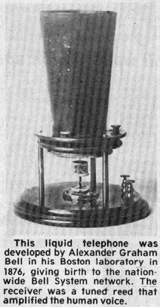
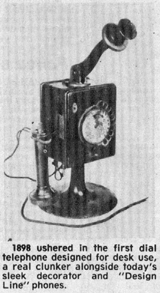
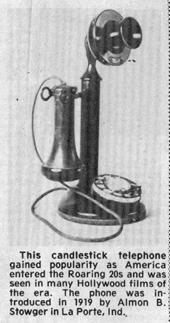
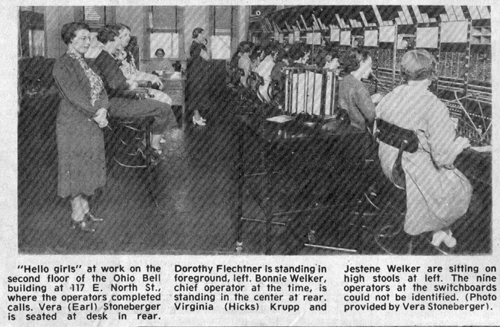
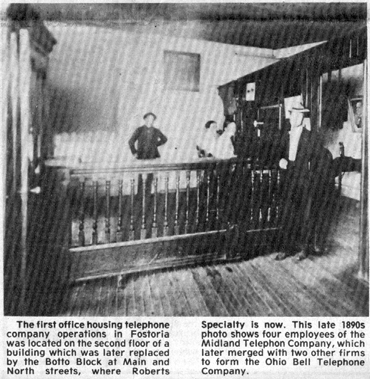
Picture #1 – This liquid telephone was developed by Alexander Graham Bell in his Boston Laboratory in 1876, giving birth to the nationwide Bell System network. The receiver was a tuned reed that amplified the human voice. 1898 ushered in the first dial telephone designed for desk use, a real clunker alongside today’s sleek, decorator and Design Line phones. This candlestick telephone gained popularity as America entered the Roaring 20s and was seen in many Hollywood films of the era. The phone was introduced in 1919, by Almon B. Stowger in La Porte, IN.
Picture #2 – “Hello girls” at work on the second floor of the Ohio Bell building at 117 E. North St., where the operators completed calls. Vera (Earl) Stoneberger is seated at desk in rear. Dorothy Flechtner is standing in foreground, left Bonnie Welker, chief operator at the time is standing in the center at rear. Virginia (Hicks) Krupp and Jestine Welker are sitting on high stools at left. The nine operators at the switchboards could not be identified.
Picture #3 – The first office housing telephone company operations in Fostoria was located on the second floor of a building which was later replaced by the Botto Block at Main and North Streets, where Roberts Specialty is now. This late 1890’s photo shows four employees of the Midland Telephone Company, which later merged with two other firms to form the Ohio Bell Telephone Company.
Six years after Alexander Graham Bell invented the telephone in 1876. Fostoria was introduced to the amazing new way to talk to the butcher, grocer, baker, doctor, and friends – anywhere in town – without leaving their homes.
It was in the March 17, 1882 edition of The Fostoria Review, predecessor to The Review Times, that a news item announced petitions were being circulated to obtain a sufficient number of signatures to guarantee a local phone exchange.
A month later it was reported that a franchise had been granted to the Midland Telephone Company to provide the new service in Fostoria. Shortly thereafter, on June 6, 1882, it was available initially 25 businesses and three residences signed up.
The names of officers of the new company were not published and it is not known if the company was locally owned. The office for the new business was in a building at the corner of Main and North where the Botto Block was later built. The telephone exchange on the second floor is shown in one of the photos.
The 1889-90 city directory showed a listing for Central Telephone Station with George Sheibley as manager, with no mention of Midland. The location was 125 1/2 N. Main street.
CUSTOMERS DOUBLED IN TWO YEARS
When Midland started telephone service here, the venture was financed by selling toll coupon books valued at $5 and $10. at the end of 1883, the number of telephone customers on Midland’s lines were 56 from the initial figure of 28. In that same year, long distance calls could be made from Fostoria to Toledo, Findlay, Tiffin and Fremont.
In 1889 another telephone exchange citizens Telephone and Message Co., introduced telephone service in Fostoria. J.C. Rhodes was manager. They continued to serve customers until about 1915, the last directory in which it was listed. Rhodes was the manager for the life of the company. It was located at 116 1/2 Main Street, but later and up to the time of its dissolu- tion it was at 121 E. Tiffin street.
During those competitive years of the two exchanges, most businesses and professional offices had both phones.
HUNDREDS ATTEND L.D. DEMONSTRATION
March 21, 1895 was a gala day for Fostoria, especially those who had Central Union telephones. It marked the opening of long distance lines from Fostoria to Cleveland, New York, Buffalo, Pittsburgh, Chicago and Indianapolis.
Historical accounts reveal that hundreds of people came to the reception at the Earl Hotel, East Tiffin Street, where Central Telephone arranged 40 telephones around a table so folks could listen in on conversation and music in distant cities.
In 1922, Central Union became part of Ohio Bell. The various managers for that company, including Sheibley and Shabenshue, were: W.D. Crawford, 1899- 1908; C.J. Strouse, 1908-25; C.A. Hall, 1926-28; H.L. Snook, 1928-30; J.D. Sherck, 1930-32; C.A. Mellon, 1932-38; C.H. Swift 1938-43; Oscar Brenner, 1947-67; Terry Caldwell, 1968-80. William Taylor was customer service manager in 1981 at which time that function was transferred to Ohio Bell offices in Toledo.
BRENNER LONGEST BUSINESS MANAGER
C.J. Strouse, mentioned above, was the father of Curtis Strouse, a well-known Fostorian who grew up here. Oscar Brenner served Ohio Bell as a local manager longer than any other. The Brenners continued to live in Fostoria after his retirement. He died Jan. 27 after a long illness.
The early days of telephone service and the equipment used then provides many memories for Fostoria’s senior citizens, including myself.
I recall the first telephone call I ever made. It was placed from Amanda Sayre’s millinery store on the second floor of the building at Main and Center, where City Loan is now. The call was to Wilbur sheely, a friend who had moved from McDougal Street to a farm where Meadowlark Park is now. Their house still stands at that location.
Back then, to place a call you lifted the receiver and a telephone operator said “Number Please” Wilbur’s number was 985. I remember it after at least 65 years. I gave the operator the number and soon was talking with Wilbur. I don’t recall our conversation, but it was thrilling to place the call on the device.
Accompanying illustrations show typical telephone equipment back then (including the “hello girls” seated at the switchboard, where the “caller” was joined with the “called” by the operator.
PEOPLE AND HOUSES ON CROCKER STREET
Esther Shaffer continues reminiscing about the north side of Crocker street, starting at Poplar.
NO. 208 – John and Luella Cramer and son Ralph lived there. Two other sons lived in Cleveland and one son, Basil, was killed in World War I. Ralph’s friends were always welcome and his mother would listen to their problems and ideas. Recently, the Cramer family Bible turned up in Fremont and it may be returned here.
NO. 212 – This was the residence of Mr. and Mrs. Robert Doke and daughter Shirley. Mr. Doke had a grocery store on East Tiffin street, with Shirley the bookkeeper and assistant manager.
Another grocer lived there also, Mr. Leibengood. He was the manager of the A & P Store on Center Street. Besides Mrs. Leibengood there was Myron and a sister. Myron was in the Fostoria High school championship bands and on the high school debating team.
The Frank Deer family lived there too. The sons were Robert and Norman and their sister Ruth. The men did house painting and repairs, and Robert served in World War II. The Deers also cared for foster children for the county. Robert was Fostoria’s Safety-service director a few years ago.
NO. 218 – This was home to the Daniel Musser family, sons Harry and James and daughters Ida Mary (called Rose), Harriett and Carrie. Mr. Musser was a rural mail carrier. Both Rose and Harriett assisted Mrs. Ella Robbins, librarian at the McClean Public Library. Rose kept the house. Harriett, the artist one, played the piano, taught guitar and did china painting. Carrie tried teaching school, didn’t like it and started to work in office positions at Gray Printing and must have liked it because she stayed there 50 years. All the girls helped care for their mother who was bedfast for five years. Mrs. Musser lived to be 104. Harry died young and James who had polio and walked on crutches died in his early 20s. The family moved to 134 W. Crocker St. in the early 1920’s and kept it as rental property.
Others living there were Mr. and Mrs. Natal Navidad Nacci. Mr. Nacci was a Spanish teacher at Fostoria High School. Mr. and Mrs. Fred Hollinger and son also lived there.
NO. 230 – Mr. and Mrs. James Housel rented this house. He had been a railroad conductor on almost every line in the country. As a young man, he had made a hobby of going anywhere a railroad went and being paid for it. He married Sarah Gay, took her with him to Mexico and tried out the railroad there after the American ones became too tame. He retired to Fostoria where he was shipping director for the Carbon Works.
A family named Heilman owned the property for quite a long time. They were retired farmers who rarely stepped outside their door.
Mr. and Mrs. Thomas Kinn and their children, Anthony, Alvin and Esther also lived there. Mr. Kinn started a garage and auto repair shop and the sons learned their trade by working there. The house was owned at one time by a family named Lamberjack.